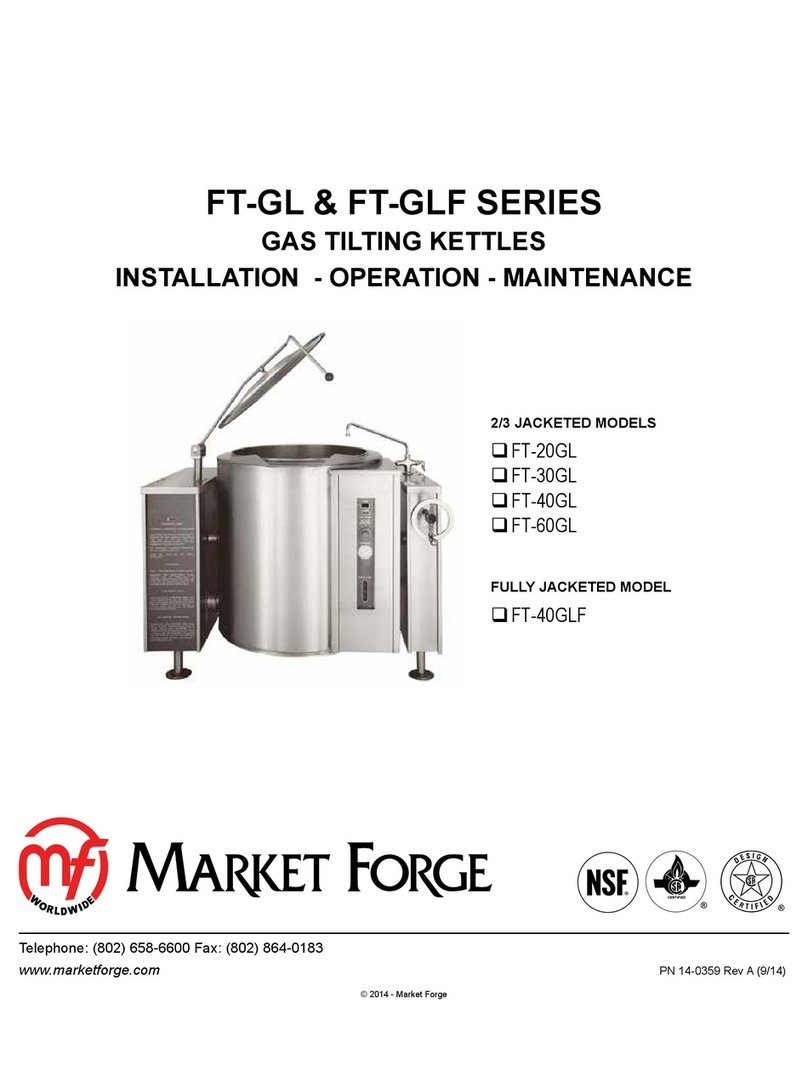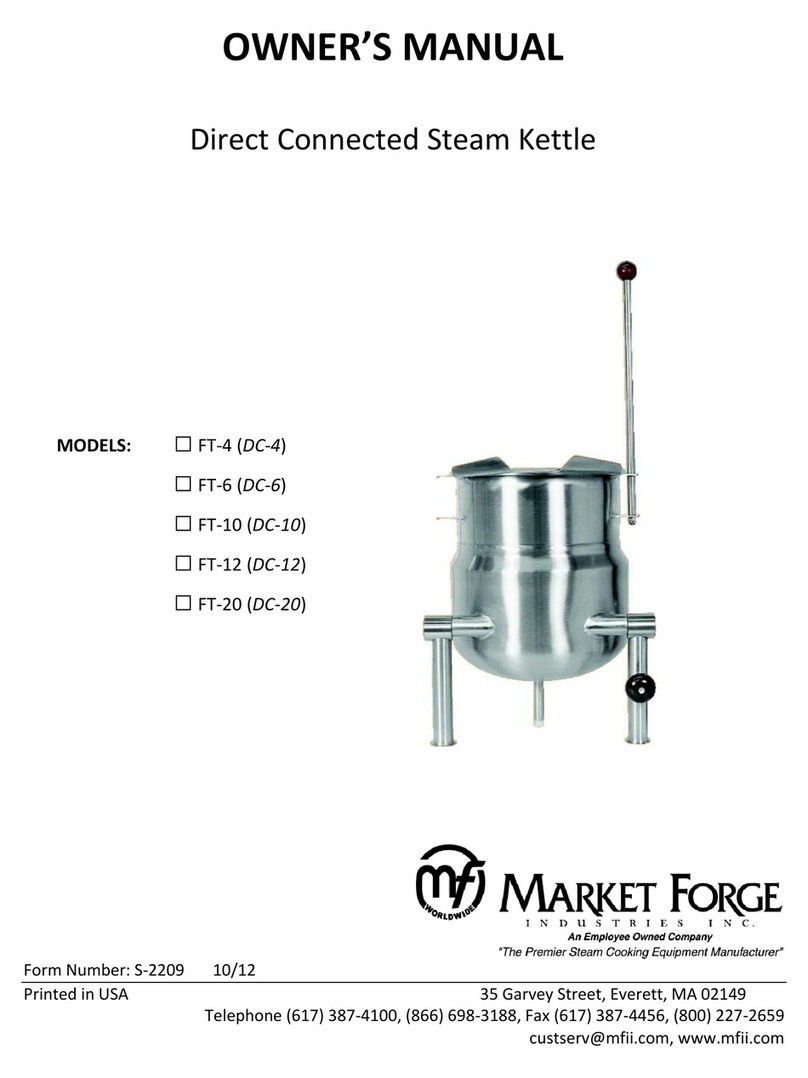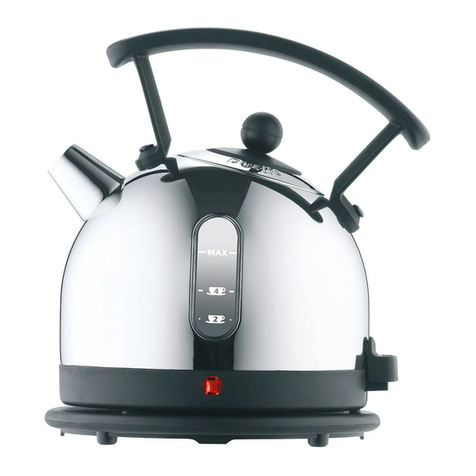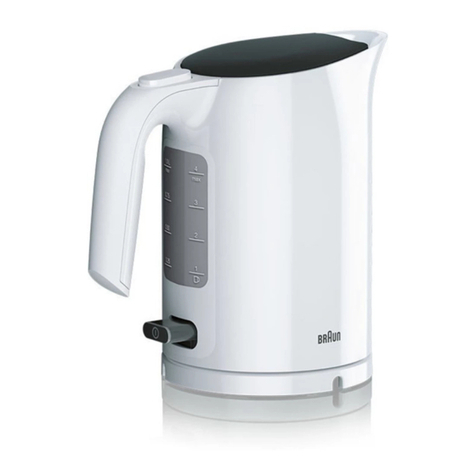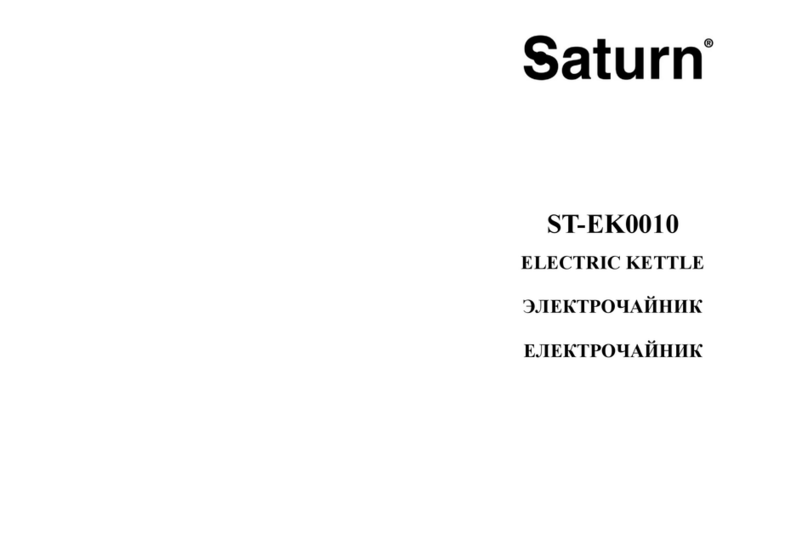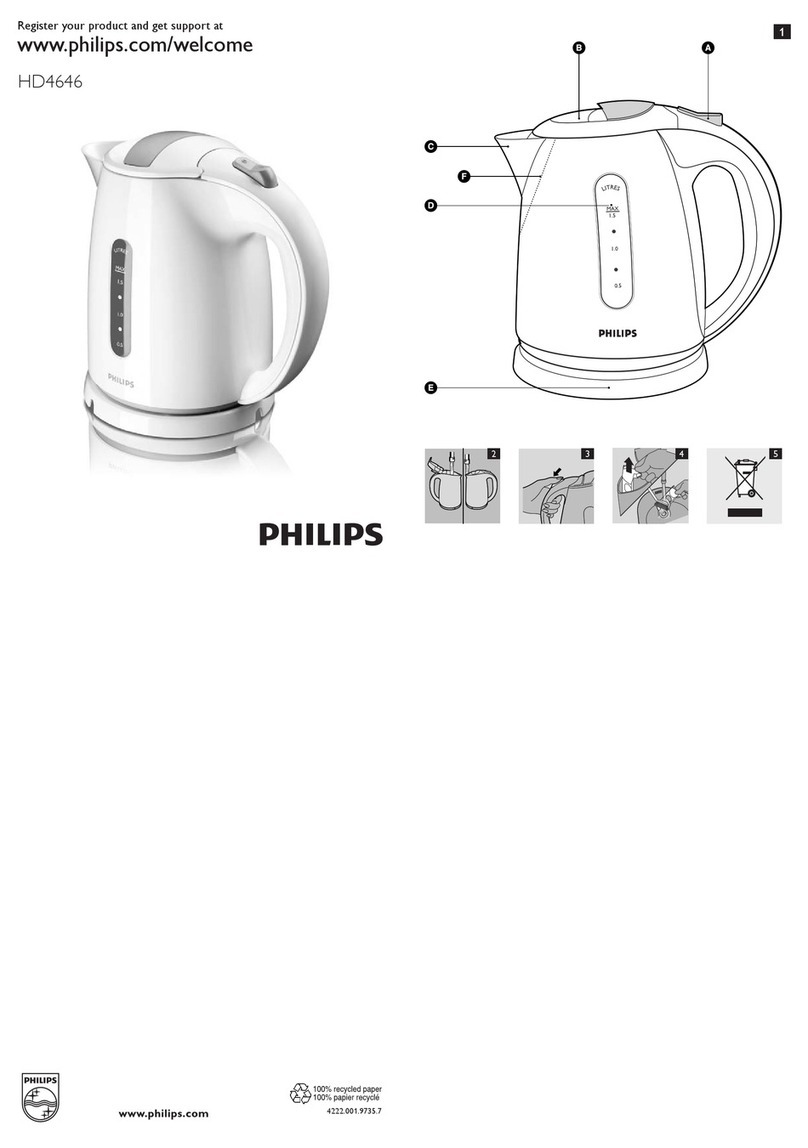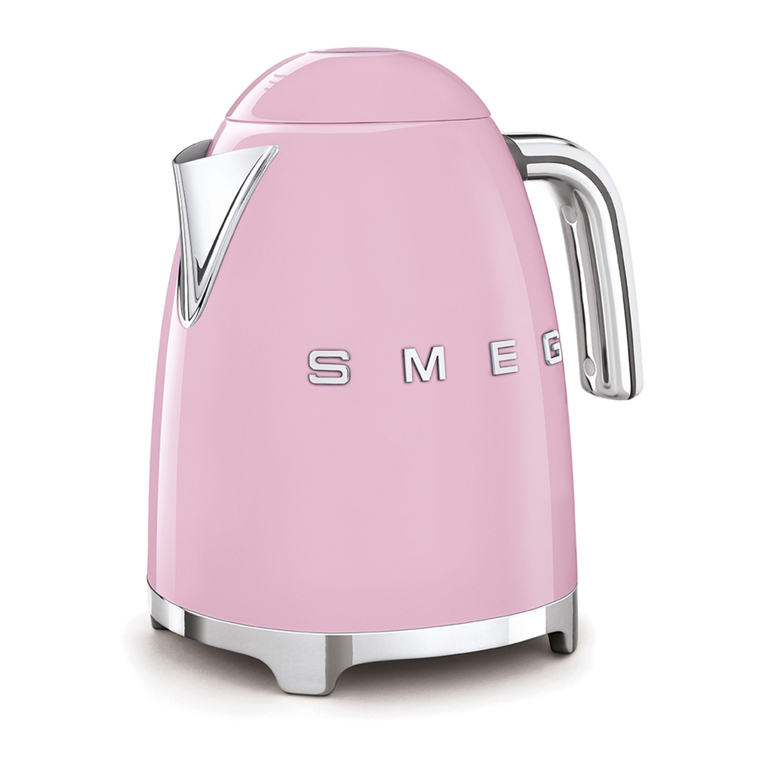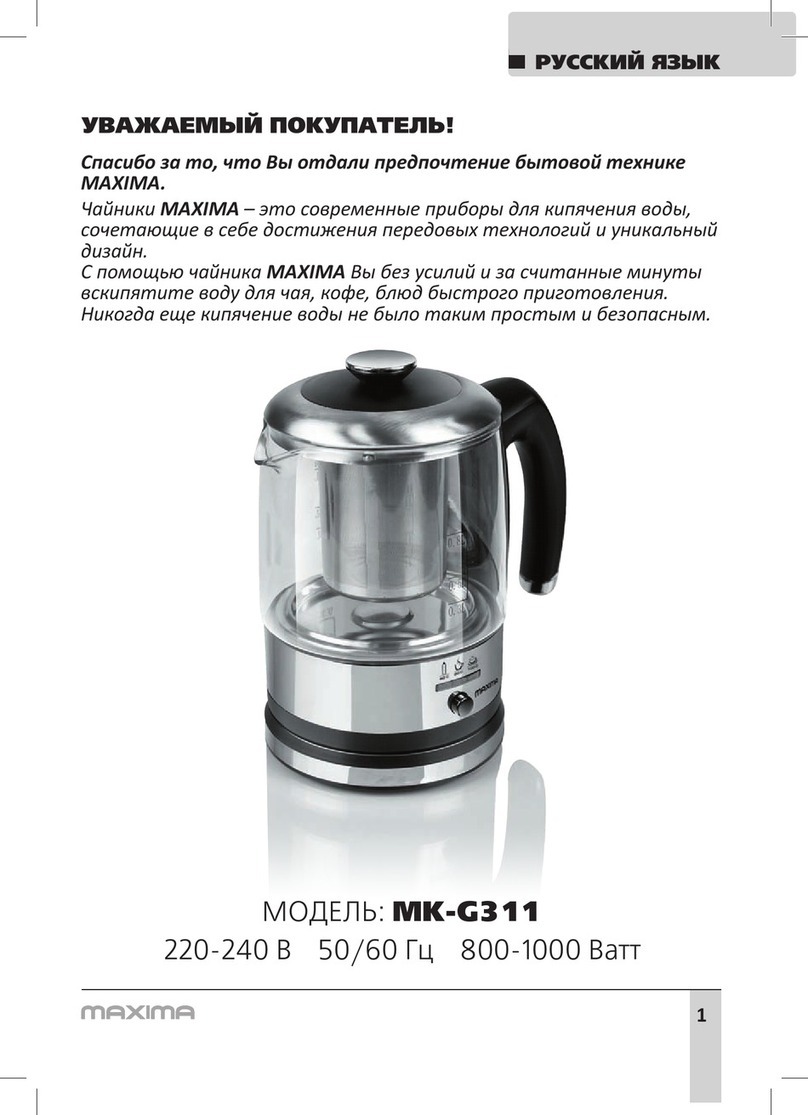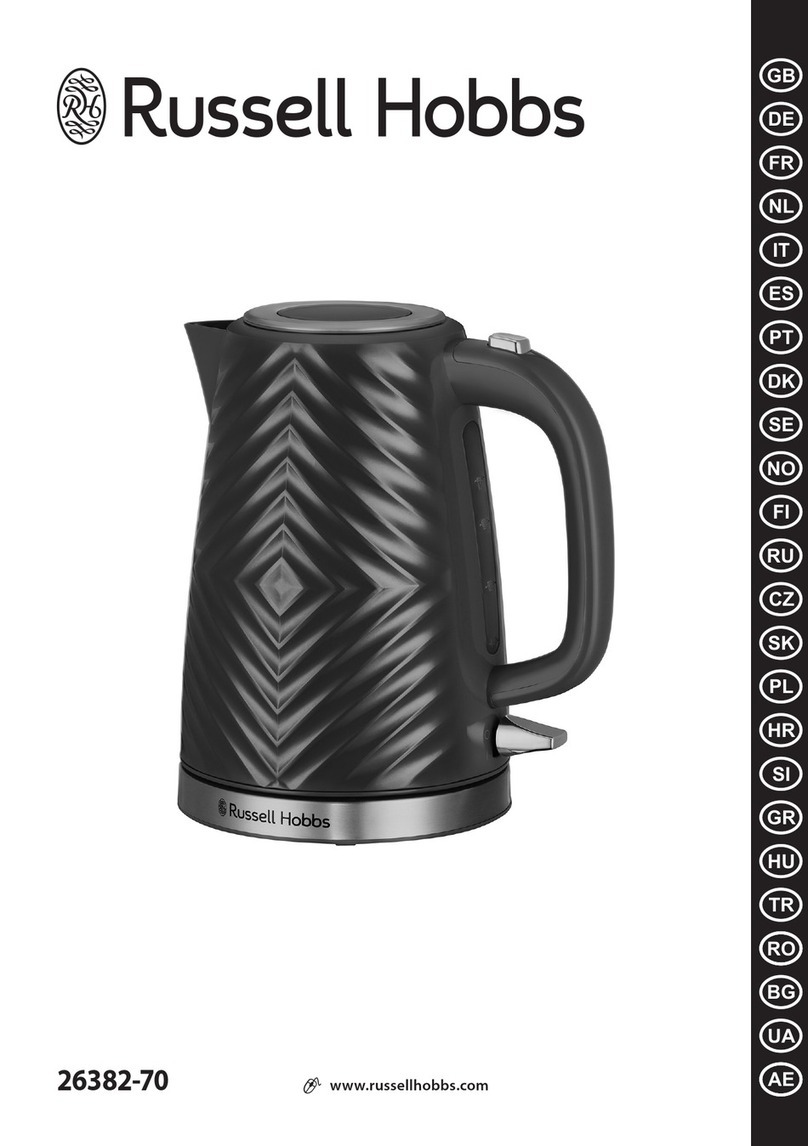Market Forge Industries FT-12CG Instruction manual

FT-12CG
GAS FIRED STEAM JACKETED TILTING KETTLE
INSTALLATION - OPERATION - MAINTENANCE
Telephone: (802) 658-6600 Fax: (802) 864-0183
www.marketforge.com PN 14-0366 Rev A (9/14)
© 2014 - Market Forge

Your Service Agency’s Address:
Model
Serial number
Oven installed by
Installation checked by

TABLE OF CONTENTS
INSTALLATION
Introduction.............................................................. 2
Service Connections ..................................................... 3
Gas and Electrical Information ............................................ 4
Installation Instructions ................................................... 5
OPERATION
Operating Instructions .................................................... 6
MAINTENANCE
Cleaning ................................................................ 7
IMPORTANT
WARNING: Improper installa-
tion, adjustment, alternation,
service or maintenance can
cause property damage, in-
jury or death. Read the instal-
lation, operation and mainte-
nance instructions thoroughly
before installing or servicing
this equipment.
INSTRUCTIONS TO BE FOL-
LOWED IN THE EVENT THE
USER SMELLS GAS MUST BE
POSTED IN A PROMINENT LO-
CATION. This information may
be obtained by contacting your
local gas supplier.
FOR YOUR SAFETY
Do not store or use gasoline or
other ammable vapors or liq-
uids in the vicinity of this or any
other appliance.
The information contained in this
manual is important for the prop-
er installation, use, and mainte-
nance of this oven. Adherence
to these procedures and instruc-
tions will result in satisfactory
baking results and long, trou-
ble free service. Please read
this manual carefully and retain
it for future reference.
ERRORS: Descriptive, typo-
graphic or pictorial errors are
subject to correction. Speci-
cations are subject to change
without notice.

2
INSTALLATION
Introduction
DESCRIPTION:
Model FT-12CG (12 gallon capacity) gas red, self-con-
tained, tilting kettle. The kettle has a jacket of double-wall
construction forming a sealed reservoir around the lower
two-thirds of the kettle. The reservoir is charged with dis-
tilled water. The kettle is equipped with a “clean lock” to
hold kettle in cooking position or tilted 105 degrees for
ease of cleaning. The kettle is also equipped with au-
tomatic ignition, low water cut off and tilt switch, which,
when activated, shuts down the burner.
BASIC FUNCTION:
The kettle operates by generating steam in the kettle res-
ervoir. The sequence of operation is as follows:
1. Operator turns the power switch to the on position
and sets the temperature control dial to the desired
setting.
2. The red light comes on indicating the kettle is heating.
The green “IGNITION” light comes on indicating that
the ignition and burner are active.
3. Once the kettle reaches the set temperature, the red
“TEMPERATURE” light and the green “IGNITION”
light extinguish.
4. All kettles are supplied with sufcient water in the
jacket. If for any reason the water level falls below
the required amount to operate the kettle, the burner
shuts down and the amber light comes on.
5. The sight glass indicates the water level within the
kettle jacket.
6. The relief valve is a safety feature which prevents
the internal kettle pressure from exceeding 50 PSI. It
should never be tampered with.

3INSTALLATION
Service Connections
SERVICE CONNECTIONS
EC Electrical Connection - Unless otherwise specified, field wire electrical connection to be 120V, 60 Hz, 1 Phase with ground-
ing wire. Unit Furnished with 8’ cord and 3-prong plug. Total max AMPS 2.0
GGas Connection - Supply gas through 3/4” pipe. Natural 6”-14” W.C. (152-355mm). Propane 12”-14” W.C. (305-355mm).
Contact manufacturer for installation over 2,000 ft elevation.
CW Cold Water - 3/8” O.D. tubing to faucet (optional).
HW Hot Water - 3/8” O.D. tubing to faucet (optional).
DIMENSIONS ARE IN INCHES [MM]
G
25.39
[645]
EC
4.75 [121]
3 [76]
23.75
[603] FLANGE FOOT DETAIL
4 EQUALLY SPACED
Ø7/16 [11] HOLES ON
3 [76] B.C.
Ø20 [508]
Ø16.75
[425] I.D.
15.88
[403]
30 [762] 6
[152]
55.75 [1416]
49.75 [1264]
32.88 [835]
23.88 [607]
6 [152] MIN
G
EC
POUR
PATH 12.5
[317]
5.5
[140]
7.75 [197]
51.25 [1302]
15 [381]
11.25
[286]
17.25
[438]
Figure 1

4
INSTALLATION
Gas and Electrical Information
INSTALLATION CODES AND STANDARDS
Installation must conform with local codes, or in the ab-
sence of local codes, with the National Fuel
Gas Code, ANSI Z223.1/NFPA 54, or the Natural Gas and
Propane Installation Code, CSA B149.1, as applicable.
1. The appliance and its individual shut off valve must
be disconnected from the gas supply piping system
during any pressure testing of that system at pres-
sures in excess of 1/2 PSI (0.03 kg/cm2) (3.5 kPa).
2. The appliance must be isolated from the gas supply
piping system by closing its individual manual shut off
valve during any pressure testing of the gas supply
piping system at test pressures equal to or less than
1/2 PSI (0.03 kg/cm2) (3.5 kPa).
Electrical grounding must be provided in accordance with
local codes, or in the absence of local codes, with the
National Electrical Code, ANSI/NFPA 70, or the Canadian
Electrical Code, CSA C22.2, as applicable.
Ventilation must be provided in accordance with local
codes, or in the absence of local codes, with ANSI/NFPA
96 Standard for Ventilation and Fire Protection of Com-
mercial Cooking Operations.
WARNING
ELECTRICAL GROUNDING INSTRUCTIONS
This appliance is equipped with a three-prong
(grounding) plug for your protection against
shock hazard and should be plugged directly
into a properly grounded three-prong recepta-
cle. Do not cut or remove the grounding prong
from this plug. (120V units only).
The electrical wiring diagram is located inside the right
hand console of the appliance.
GAS CONNECTION
WARNING
Do not connect the appliance to the electrical
supply until after the gas connection has been
made.
CAUTION
The pipe thread compound used when install-
ing pipes must be a type that is resistant to
the action of liqueed petroleum or propane
gases.
1. The Serial and Rating Plate on the unit indicates the
type of gas your unit is equipped to burn. DO NOT
connect to any other gas type.
2. A 3/4” NPT line is provided at rear for the connec-
tion. The unit is equipped with an internal pressure
regulator which is set at 4” W.C. manifold pressure for
Natural Gas and 10” W.C. for Propane Gas. Use 1/8”
pipe tap on the union elbow assembly located in the
console for checking pressure.
An adequate gas supply is imperative. Undersized or low
pressure lines will restrict the volume of gas required for
satisfactory performance. A steady supply pressure, mini-
mum 6 inch W.C. for natural gas and minimum 12 inch
W.C. for propane gas is recommended. With all units op-
erating simultaneously, the manifold pressure on all units
should not show any appreciable drop.
Fluctuations of more than 25% on natural gas and 10%
on propane gas will create problems, affecting burner op-
eration. Contact you gas company for correct supply line
sizes. Purge the supply line to clean out any dust, dirt or
other foreign matter before connecting the line to the unit.
Use pipe joint compound which is suitable for use with
L.P. on all threaded connections.
Test pipe connections thoroughly for gas leaks.
WARNING
Never use an open ame to check for gas
leaks. Check all connections for leaks using
soapy water before use.
NOTICE
If this equipment is being installed at over
2,000 feet altitude and was not so specied on
order, contact service department. Failure to
install with proper orice sizing may void the
warranty.

5INSTALLATION
Installation Instructions
1. Uncrate carefully. Report any hidden freight damage
to the freight company immediately.
2. Ideally an exhaust system should be directly above
the appliance to exhaust combustion gases gener-
ated by the unit.
3. The appliance is intended for use on noncombustible
oors. The minimum clearance from combustible and
noncombustible oor construction is 0” on right side,
0” on left side and 6” (152 mm) from the back of the
ue chimney.
4. Appliance location must allow air supply to unit and
obstruction free clearance for air opening into the
combustion chamber.
5. Set the appliance in place and level using spirit level.
Level left to right and front to back.
6. Mark hole locations on the oor through the anchor-
ing holes provided in the anged adjustable feet.
7. Remove the appliance from installation position and
drill holes in locations marked on the oor. Insert
proper anchoring devices. (Not supplied).
8. Place appliance back in the installation position and
Re-level left to right and front to back.
9. Bolt and anchor appliance securely to the oor.
10. Seal bolts and anged feet with silastic or equivalent
compound.
11. Make service connections as indicated.
12. The pressure relief valve is located at the left rear of
the unit. This area should be kept clear and should
not be in an area where operators will normally stand.
The elbow on the relief valve should be turned toward
the oor. 3/4” diameter pipe may be used to extend to
the oor, but must not be piped directly to a drain. It
must be vented to the atmosphere.
13. Check the pressure gauge on the front panel before
operating. The reading should be in the green vacu-
um zone (below 0 PSI).

6
OPERATION
Operating Instructions
FRONT PANEL CONTROLS:
Power Switch
This switch turns the main power to the unit on and off. It
must be turned on to heat the kettle. It should be turned
off when the kettle will not be in use for long periods.
Thermostat
Selects the desired internal kettle operating temperature.
It also turns on the temperature light (red) and ignition
light (green).
Temperature Pilot Light (Red)
When the kettle has reached set temperature, tempera-
ture light (red) will go off.
Ignition Pilot Light (Green)
Comes on with temperature light (red) and indicates igni-
tion has occurred. Should it not come on with temperature
light, this would indicate failed ignition or burnt out light.
Low Water Light (Amber)
All kettles are supplied with sufcient water in the pressur-
ized jacket. If at any time the water level falls below that
required for proper operation, the kettle will not heat and
this light will come on.
Pressure Gauge
The pressure gauge indicates the internal operating pres-
sure of the kettle.
Sight Glass
The sight glass indicates the water level within the kettle
jacket.
Pressure Relief Valve
The pressure relief valve is a safety device which pre-
vents the internal kettle pressure from exceeding 50 PSI.
It should never be tampered with.
TILTING INSTRUCTIONS
Your kettle has the standard “Clean Lock” feature and
may not be tilted without disengaging the tilt knob located
on the console at the top left. This feature locks the ket-
tle in the upright position and also allows the operator to
lock the kettle at 105 degrees for ease of cleaning. Follow
these steps to tilt kettle:
1. Pull out the tilt knob at the top left of console.
2. Using kettle tilt handle, pull kettle forward to desired
angle of pour or until kettle locks at 105 degrees. The
tilt knob can be released after the kettle has been
tilted approximately 10 degrees.
3. Kettle will lock in position at 105 degrees and may be
tilted further by pulling the tilt lock knob a second time
allowing the kettle to tilt the full distance.
4. To return the kettle to the upright position, pull out the
tilt lock knob and tilt the kettle upward until it locks
in the upright position. The kettle should not move in
either direction once in the upright position.
LIGHTING
1. Ensure the kettle is in the upright position.
2. Open the manual gas shut off valve located at the
back of the right-hand console when facing the front
of the unit.
3. Set the thermostat dial in off position. Turn the power
switch on.
4. Set the thermostat to desired setting.
NOTE: Ignition may not occur at a setting below 2 –
3 on thermostat dial. If ignition light does not
stay on, turn off thermostat. Wait ve minutes
and repeat the lighting procedure.
WARNING
In the event of main burner ignition failure, a
5 minute purge period must be observed prior
to re-establishing ignition source.
SHUT DOWN
1. Turn thermostat dial to “OFF” position.
2. Turn power switch to “OFF” position.
3. Close manual gas shut-off valve.

7MAINTENANCE
Cleaning
WARNING
Disconnect the power supply to the appliance
before cleaning or servicing.
WARNING
Never spray water into electric controls or
components!
CAUTION
The equipment and its parts are hot. Use care
when operating, cleaning and servicing.
CAUTION
Do not use cleaning agents that are corrosive.
Your kettle should be cleaned immediately after each use
or when cooking a different product.
Before cleaning, check that the kettle has cooled enough
to touch it.
1. Rinse the inside of the kettle thoroughly and drain to
remove any food particles.
2. Using a nylon brush, clean the kettle with a mild de-
tergent ad water. Never use steel wool or scouring
powder as it will scratch stainless steel. Plain steel
wool can leave small pieces of steel which can rust.
3. Rinse the inside of the kettle thoroughly with clean
water. Drain the kettle by tilting, to allow the detergent
and water solution to drain.
4. Wipe the exterior of the kettle with a clean, damp
cloth.
WHAT TO DO IF SURFACE RUST APPEARS
Metal utensils should never be used as they will scratch
the surface of the equipment and rust may begin to form.
To remove surface accumulation of rust from the inadver-
tent use of such utensils, the following procedure may be
used.
CAUTION
Improper use of this procedure may damage
your appliance!
1. Use undiluted white vinegar with a non-abrasive
scouring pad (plastic) or cloth on the affected area to
remove the rust stain. The appliance should not be
heated and remain at room temperature during the
entire cleaning process.
2. If the stain resists removal, additional exposure time
with vinegar may be required, to a maximum of one
hour.
3. Thoroughly wash all of the vinegar away with fresh
clear water. Dry the surface completely and allow one
hour before using the appliance to cook.
Following daily and period maintenance procedures will
prolong the life of your equipment. Climatic conditions -
salt air - may require more
STAINLESS STEEL
To remove normal dirt, grease or product residue from
stainless steel, use ordinary soap and water (with or with-
out detergent) applied with a sponge or cloth. Dry thor-
oughly with a clean cloth. Never use vinegar or any other
corrosive cleaner.
To remove grease and food splatters or condensed va-
pours that have baked on the equipment, apply cleanser
to a damp cloth or sponge and rub cleanser on the metal
in the direction of the polishing lines. Rubbing cleanser
as gently as possible in the direction of the polished lines
will not mar the nish of the stainless steel. NEVER RUB
WITH A CIRCULATION MOTION.
Soil and burn deposits which do not respond to the above
procedure can usually be removed by rubbing the surface
with SCOTCH-BRITE™ scouring pads or STAINLESS
scouring pads. DO NOT USE ORDINARY STEEL WOOL
as any particles left on the surface will rust and further
spoil the appearance of the nish. NEVER USE A WIRE
BRUSH, STEEL SCOURING PADS (EXCEPT STAIN-
LESS), SCRAPER, FILE OR OTHER STEEL TOOLS.
Surfaces which are marred collect dirt more rapidly and
become more difcult to clean. Marring also increases
the possibility of corrosive attack. Renishing may then
be required.
Table of contents
Other Market Forge Industries Kettle manuals
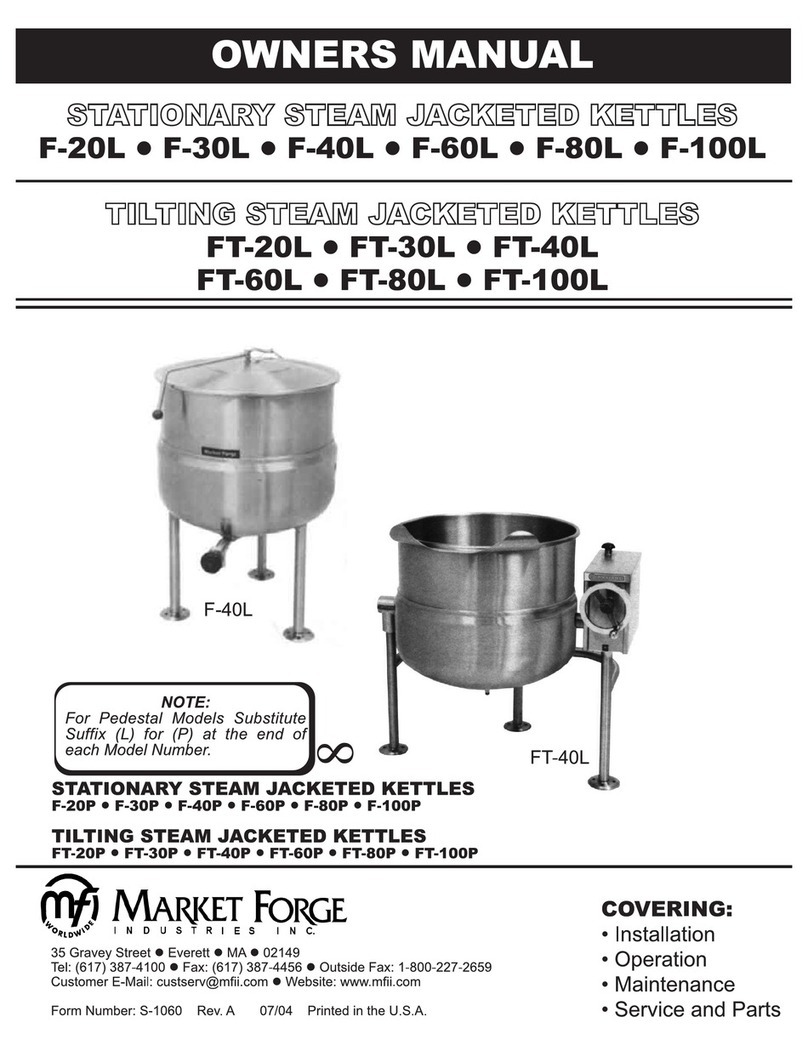
Market Forge Industries
Market Forge Industries F-20L User manual

Market Forge Industries
Market Forge Industries FT-20CE Quick start guide

Market Forge Industries
Market Forge Industries FT-20CE User manual
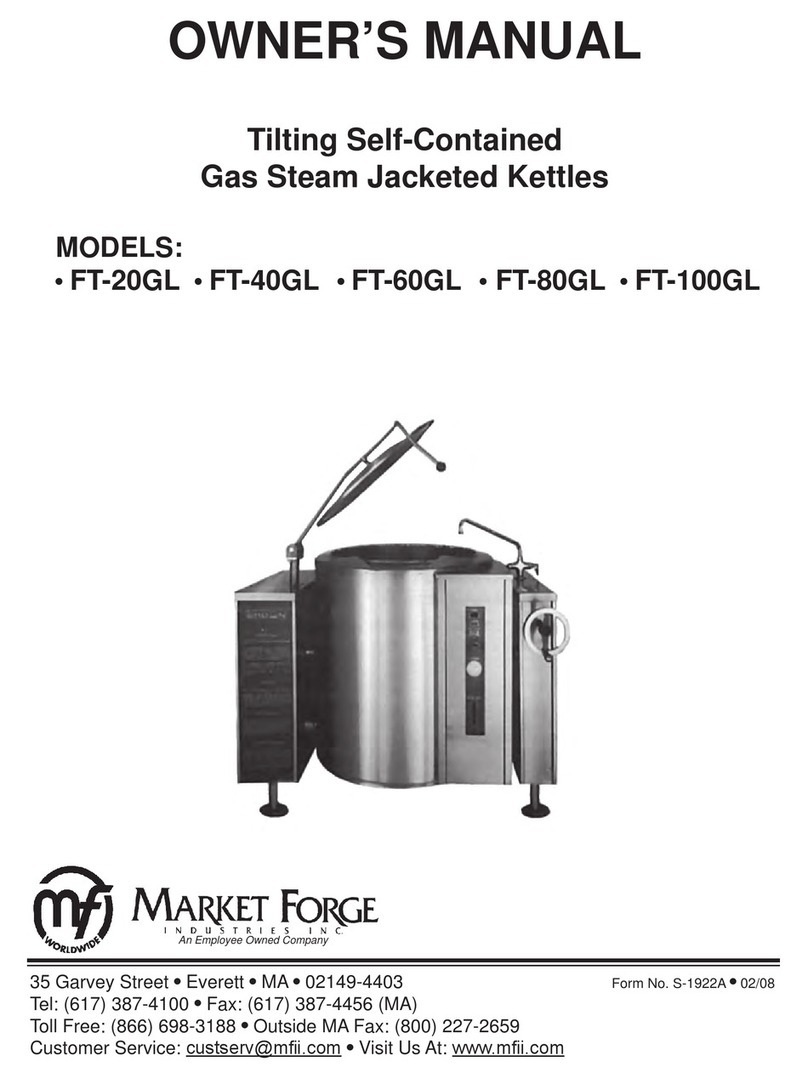
Market Forge Industries
Market Forge Industries FT-20GL User manual
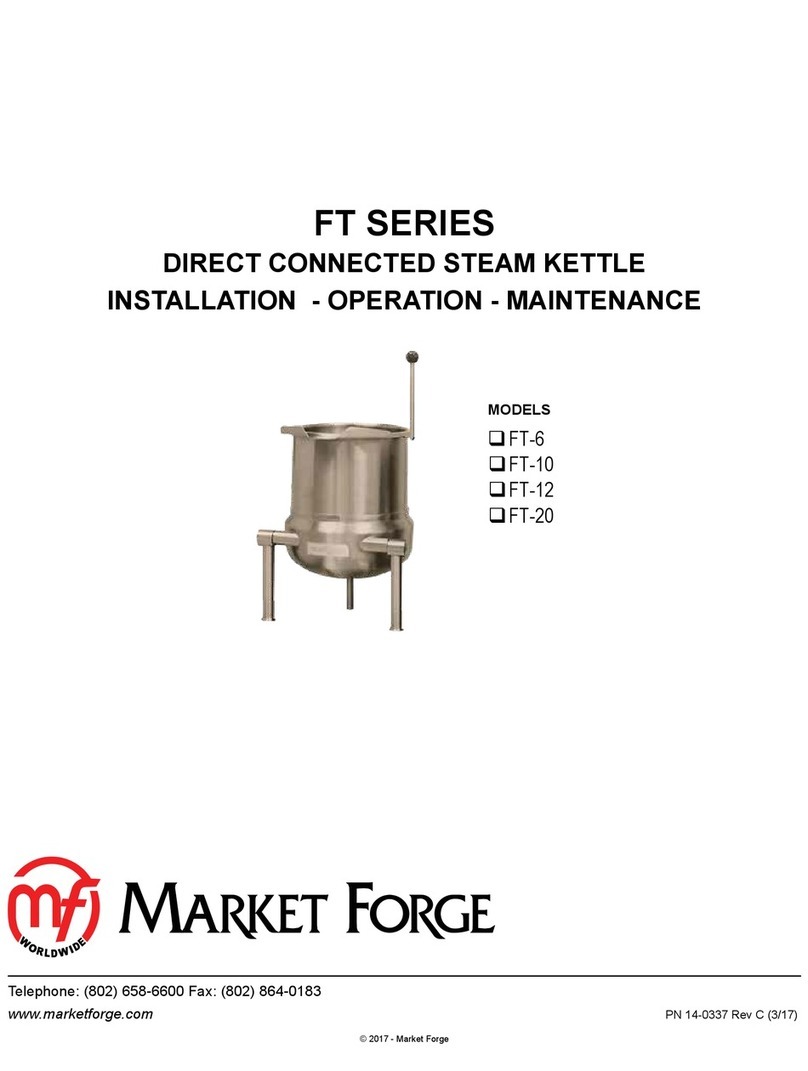
Market Forge Industries
Market Forge Industries FT Series Owner's manual
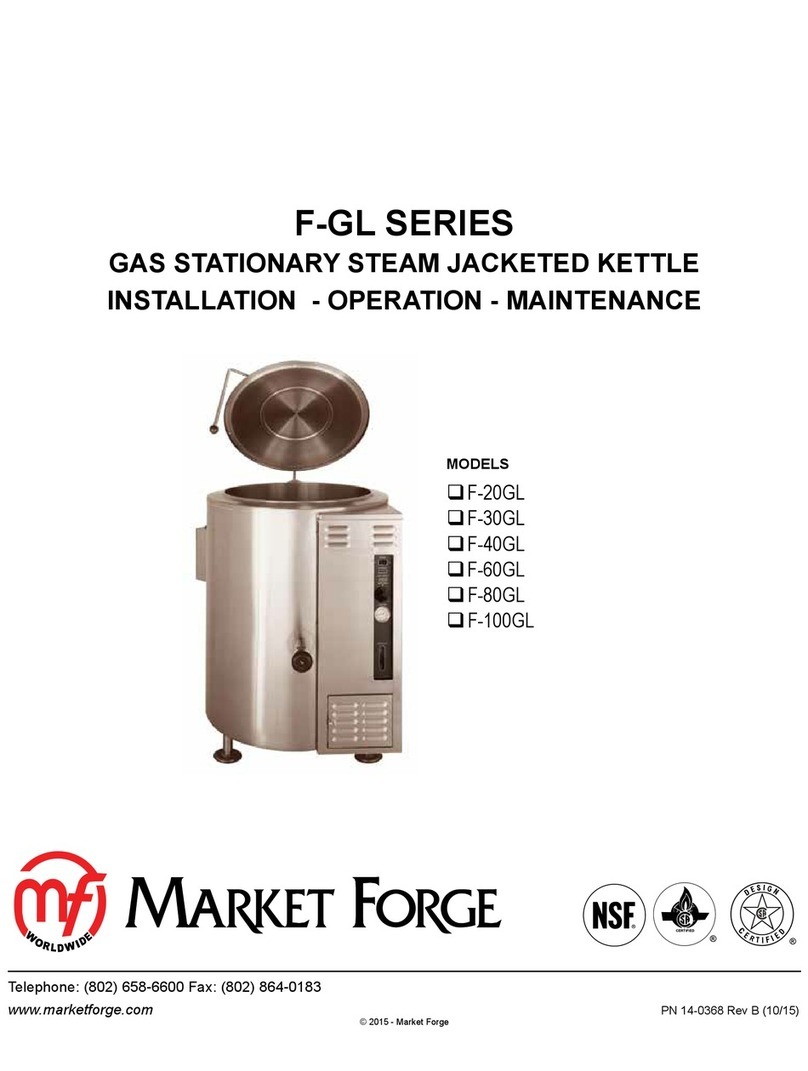
Market Forge Industries
Market Forge Industries F-GL Series Owner's manual
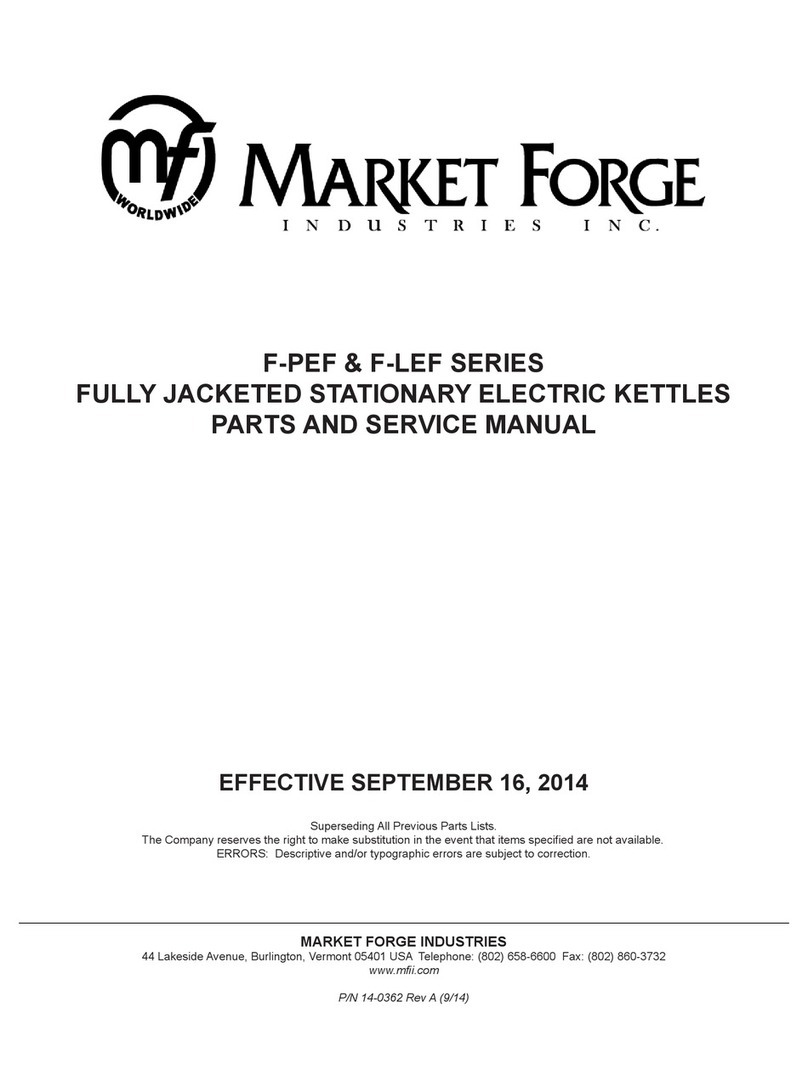
Market Forge Industries
Market Forge Industries F-PEF SERIES Quick start guide
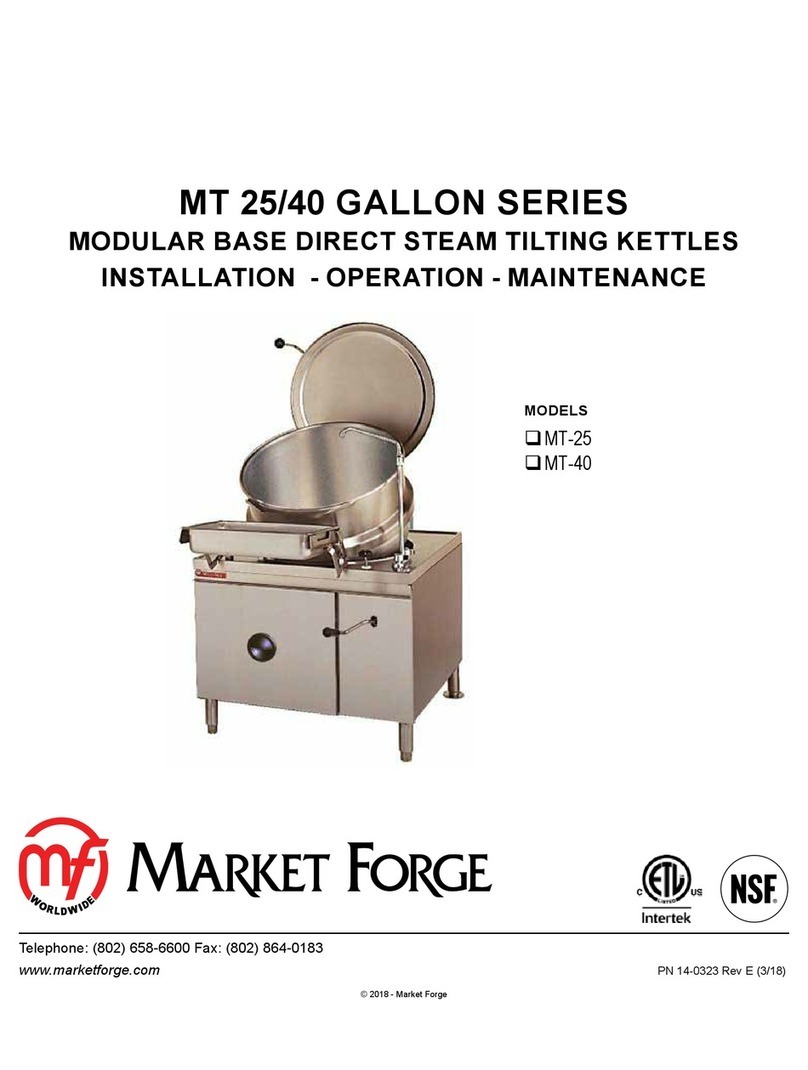
Market Forge Industries
Market Forge Industries MT-25 Owner's manual
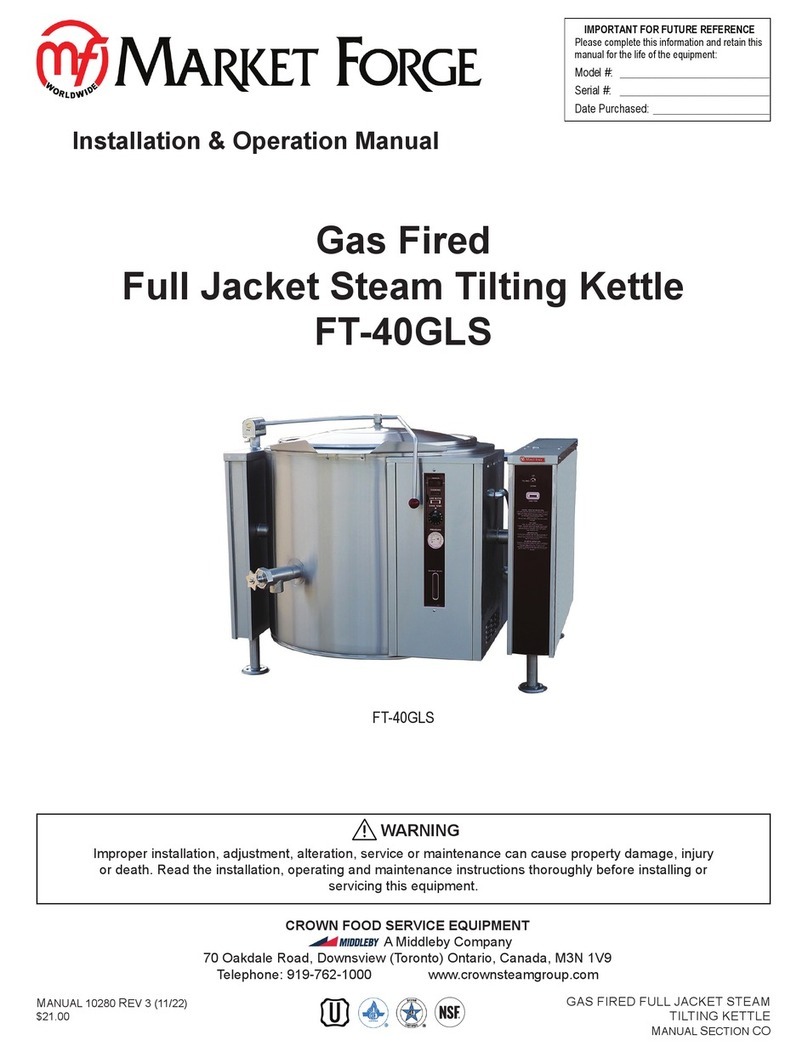
Market Forge Industries
Market Forge Industries FT-40GLS User manual
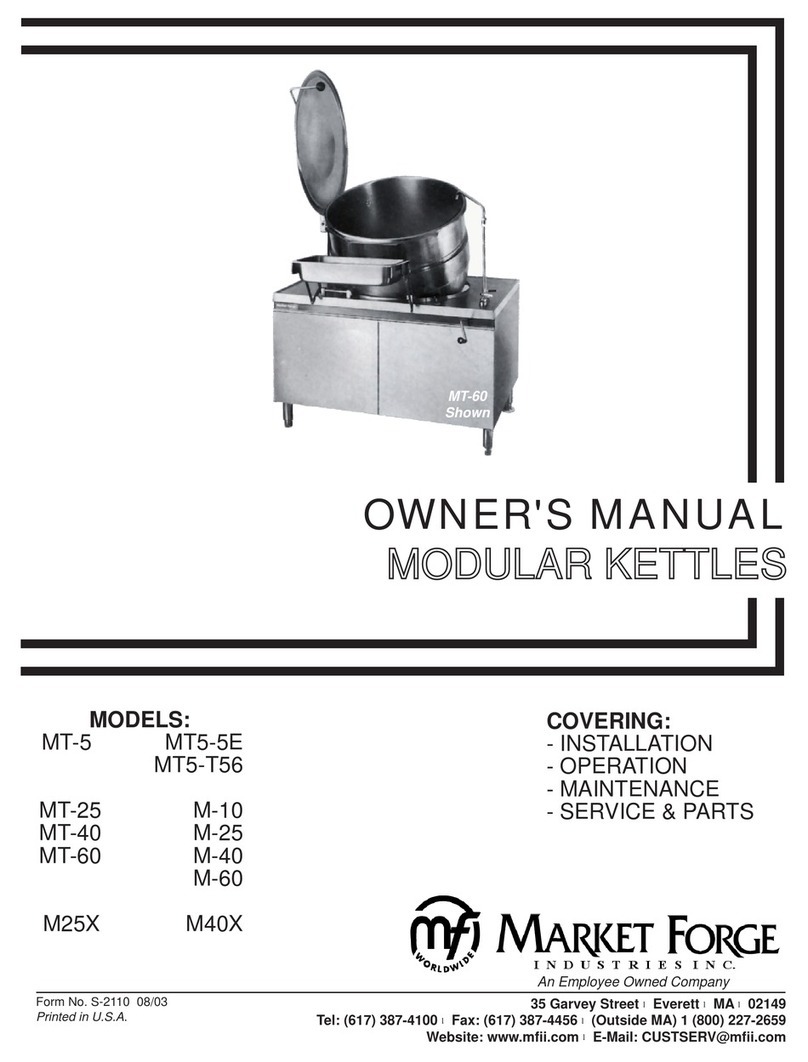
Market Forge Industries
Market Forge Industries MT-5 User manual
